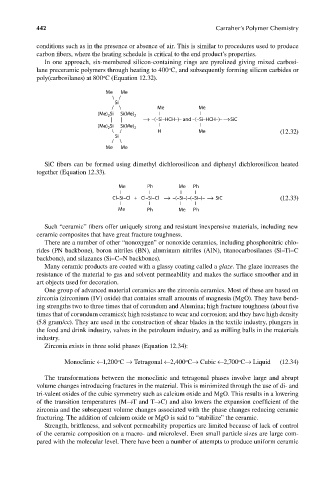Page 479 - Carrahers_Polymer_Chemistry,_Eighth_Edition
P. 479
442 Carraher’s Polymer Chemistry
conditions such as in the presence or absence of air. This is similar to procedures used to produce
carbon fibers, where the heating schedule is critical to the end product’s properties.
In one approach, six-membered silicon-containing rings are pyrolized giving mixed carbosi-
o
lane preceramic polymers through heating to 400 C, and subsequently forming silicon carbides or
o
poly(carbosilanes) at 800 C (Equation 12.32).
Me Me
\/
Si
/ \ Me Me
(Me) Si Si(Me) 2 –
2
| | –(–Si–HCH–)– and –(–Si–HCH–)– SiC
(Me) Si Si(Me) 2 –
2
––
\ / H Me (12.32)
Si
/ \
Me Me
SiC fibers can be formed using dimethyl dichlorosilicon and diphenyl dichlorosilicon heated
together (Equation 12.33).
Me Ph Me Ph
– – – –
Cl–Si–Cl + Cl–Si–Cl –(–Si–)–(–Si–)– SiC (12.33)
– – – –
Me Ph Me Ph
Such “ceramic” fibers offer uniquely strong and resistant inexpensive materials, including new
ceramic composites that have great fracture toughness.
There are a number of other “nonoxygen” or nonoxide ceramics, including phosphonitric chlo-
rides (PN backbone), boron nitriles (BN), aluminum nitriles (AlN), titanocarbosilanes (Si–Ti–C
backbone), and silazanes (Si–C–N backbones).
Many ceramic products are coated with a glassy coating called a glaze. The glaze increases the
resistance of the material to gas and solvent permeability and makes the surface smoother and in
art objects used for decoration.
One group of advanced material ceramics are the zirconia ceramics. Most of these are based on
zirconia (zirconium (IV) oxide) that contains small amounts of magnesia (MgO). They have bend-
ing strengths two to three times that of corundum and Alumina; high fracture toughness (about fi ve
times that of corundum ceramics); high resistance to wear and corrosion; and they have high density
(5.8 gram/cc). They are used in the construction of shear blades in the textile industry, plungers in
the food and drink industry, valves in the petroleum industry, and as milling balls in the materials
industry.
Zirconia exists in three solid phases (Equation 12.34):
o
o
o
Monoclinic ←1,200 C → Tetragonal ←2,400 C→ Cubic ←2,700 C→ Liquid (12.34)
The transformations between the monoclinic and tetragonal phases involve large and abrupt
volume changes introducing fractures in the material. This is minimized through the use of di- and
tri-valent oxides of the cubic symmetry such as calcium oxide and MgO. This results in a lowering
of the transition temperatures (M→T and T→C) and also lowers the expansion coefficient of the
zirconia and the subsequent volume changes associated with the phase changes reducing ceramic
fracturing. The addition of calcium oxide or MgO is said to “stabilize” the ceramic.
Strength, brittleness, and solvent permeability properties are limited because of lack of control
of the ceramic composition on a macro- and microlevel. Even small particle sizes are large com-
pared with the molecular level. There have been a number of attempts to produce uniform ceramic
9/14/2010 3:42:09 PM
K10478.indb 442
K10478.indb 442 9/14/2010 3:42:09 PM

